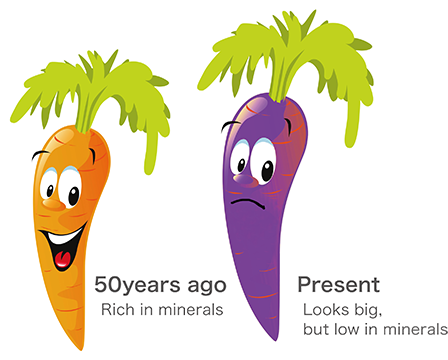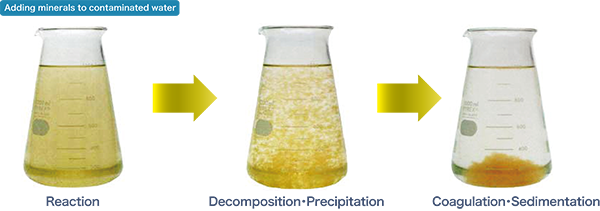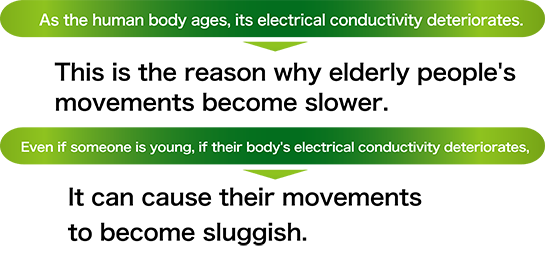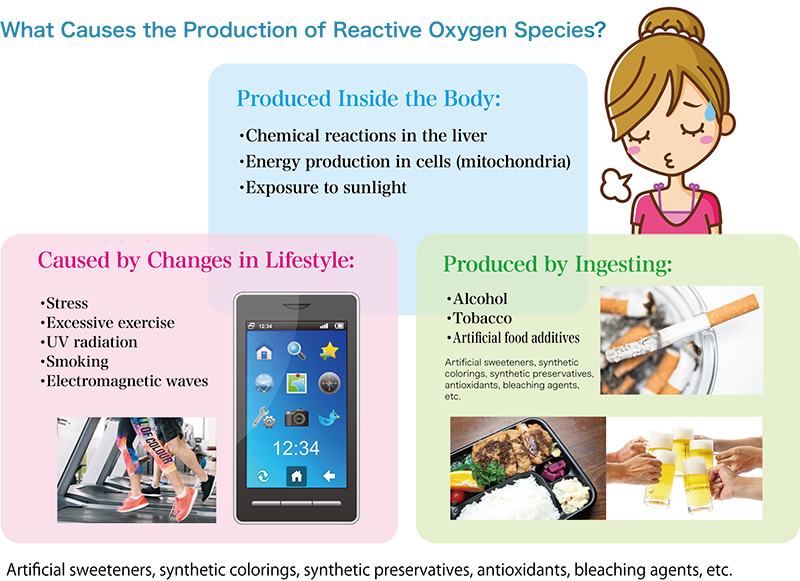Minerals, along with vitamins, are 'metallic elements necessary for the human body.
Minerals control growth, metabolism and physiological actions, maintain cell balance and sustain nerve and muscle functions properly. They are very important and essential for health maintenance and life activities.
What Are Minerals (Trace Elements)?
For living organisms, minerals (trace elements) are the most important.
It is said that there are more than 118 types of minerals on Earth. Among them, about 30 are considered essential minerals (trace elements) for humans.
These 30 elements are regarded as absolutely necessary for human health, and a deficiency in these trace elements is believed to be a cause of lifestyle-related diseases.
How much mineral content is there in the human body?
Essential minerals make up about 4% of human body weight. When plants are burned, about 80% of their water content evaporates, leaving behind ash. This remaining ash is composed of minerals.
Analyzing Our Body
What types and amounts of trace elements exist in our bodies?
Minerals (Trace Elements) Cannot Be Synthesized by the Human Body
Minerals cannot be produced within the human body. To maintain vital functions and health within cells, it is essential to intake minerals from external sources. If mineral intake is insufficient, even if the body can absorb some minerals, a deficiency may occur, leading to various diseases.
Minerals
- 0.02% are trace elements
- Iron, zinc, copper, manganese, selenium, cobalt, chromium, iodine, nickel, fluorine, vanadium, tin, silicon, titanium, molybdenum, strontium, germanium, etc.
- 3–4% are major elements
- Calcium, sodium, magnesium, potassium, sulfur, phosphorus, chlorine (7 elements)

There are issues with the mineral intake of modern people.
Plants absorb minerals from the soil, and animals obtain these minerals by eating the plants.
However, it is said that the mineral content in vegetables today is only half or even one-third of what it was 50 years ago.
This is a pitfall of modern farming, which heavily relies on chemical fertilizers.
As a result, plants are cultivated for quick, large-scale harvests without absorbing sufficient trace elements.
While modern diseases are prevalent in developed countries, their incidence is lower in developing countries, which can be attributed to the insufficient minerals in food.

Dissolving minerals in water is called “ionization”.
The minerals in Club Eco Water are extracted from specific ores containing a variety of mineral components using a unique method, resulting in a blend of over 30 different minerals.
The key feature of this process is that it maximizes the power of the ores by ionizing the minerals in water.

Contains over 30 types of minerals
Calcium, Sodium, Potassium, Magnesium, Iron, Copper, Zinc, Manganese, Aluminum, Nickel, Vanadium, Silicon, Phosphorus, Chromium, Titanium, Fluorine, Cobalt, Lithium, Strontium, Iodine, Germanium Additionally, it contains numerous other trace elements.
Safety
The levels of Arsenic, Lead, Cadmium, Total Mercury, and Hexavalent Chromium meet the drinking water quality standards.
(Analysis conducted by the Tottori Health Service Association)
What is ionization of minerals?
What is ionized mineral?
- Extracted minerals made water-soluble
-
Example: A plant releases acid from its roots to dissolve soil and absorb minerals.

- Easily absorbable by the body
- Returnable to soil (recyclable as nutrients for plants)
What is non-ionized mineral?
- Products made by extracting elements from ores:
-
Examples: Iron (nails, rebar), Aluminum (aluminum cans, aluminum window frames)

- Not absorbed by the body
- Metals like iron, aluminum, and minerals do not dissolve unless they oxidize, thus preventing metal toxicity.
Three Functions of Minerals
A significant characteristic of minerals is their ability to simultaneously perform precipitation, decomposition, coagulation, deodorization, decolorization, and disinfection of organic matter.
1.Purification Action of Minerals (Coagulation Action)
- Experiment 1
- By adding an appropriate amount of minerals to contaminated water, you can remove impurities from the water, as shown in the following photos.

Minerals catalyze oxygen, which then burns organic substances.
- Experiment 2
- Koyama Pond in Tottori City, Tottori Prefecture, has been experiencing significant eutrophication, leading to a large outbreak of blue-green algae (Aoko). We placed water from this pond into a tank.

Life Essence is added to water from Koyama-ike pond where blue-green algae generate in large quantity. Dirt of water is able to be removed at the upper part of container, and water passing through the filter and staying at the lower part of the container is purified with minerals.
Life Essence is added to the water from Koyama Pond, where a significant bloom of blue-green algae (Aoko) has occurred.
Impurities are removed in the upper part of the server, and the water that passes through the filter in the lower part becomes purified, mineral-enriched water.

2.Antibacterial Effects of Minerals
The antibacterial effects of minerals against food poisoning and pyogenic bacteria are well recognized.
High concentrations of minerals can prevent microbial growth.
They have been proven to have antibacterial effects against pathogenic bacteria responsible for food poisoning (commonly cited as major causes of food poisoning in Japan) and bacteria that trigger infectious diseases.
*For more information, please see the Analysis Data Book (sold separately).
※Tests were conducted at approximately 1/125 the concentration of the server water.

Measured Value
| Bacteria | Initial Bacterial Count (CFU/ml) |
Processing Time (minutes) | ||||
|---|---|---|---|---|---|---|
| Immediately After use | 5 | 10 | 30 | 60 | ||
| Salmonella | 1.0×105 | × | △ | △ | ○ | ○ |
| Shigella | 1.0×105 | × | △ | ○ | ○ | ○ |
| Pathogenic E. coli O157 |
1.0×105 | × | △ | △ | ○ | ○ |
| Vibrio parahaemolyticus | 1.0×105 | × | ○ | ○ | ○ | ○ |
| Cholerae bacteria | 1.0×105 | × | ○ | ○ | ○ | ○ |
| Staphylococcus aureus | 1.0×105 | × | × | × | △ | ○ |
| Campylobacter | 1.1×105 | × | ○ | ○ | ○ | - |
| Feline Calicivirus | 7.3 | × | ○ | ○ | ○ | ○ |
○:Bacterial count 20 or less △:Bacterial count between 20 to 105 ×: Bacterial count over 105
Pyogenic Bacteria
| Tested Bacteria ↓ / Treatment → | Untreated | Treated |
|---|---|---|
| Streptococcus | 4600 | 0 |
| Staphylococcus aureus | 2660 | 0 |
| Pseudomonas aeruginosa | 1.0×106 | 0 |
(Research results by the Tottori Prefectural Public Health Foundation and the Japan Food Research Center.
Minerals catalyze oxygen and oxygen burns organic substances.
Minerals are able to remove lead that causes concern about melting into tap water from lead pipes and arsenic which may be included in underground water.

Safety Confirmed by Toxicity Test Results
The safety of minerals has been confirmed through various tests, as outlined below:
- Acute Oral Toxicity Test
- Cumulative Toxicity Test
- Mouse Bone Marrow Cell Micronucleus Test (assesses potential chromosomal abnormalities)
- Ames Test(assesses potential genetic mutations)
- Fish Toxicity Test
Test results provided by the Tokyo Food Sanitation Association.

Function of Minerals
3.Catalytic Action of Minerals
Trace element minerals act as catalysts in various biochemical reactions within the body, playing a crucial role in stabilizing enzymes.
Main Functions of the Catalytic Action of Trace Elements
- Energy Production:
- Carbohydrates + Fats + Proteins + Trace Elements
- Body Composition:
- Proteins + Trace Elements (mainly Calcium and Phosphorus)
- Regulating Body Functions:
- Proteins (Enzymes) + Vitamins + Trace Elements
Excellent mineral balance!
LE (Life Essence) contains the following 30 essential minerals
Calcium, Sodium, Potassium, Magnesium, Iron, Copper, Zinc, Manganese, Aluminum, Nickel, Vanadium, Silicon, Phosphorus, Chromium, Titanium, Fluorine, Cobalt, Lithium, Strontium, Iodine, Germanium Additionally, it contains numerous other trace elements.

Reactive Oxygen Species and Oxidation
Reactive Oxygen Species and Oxidation

What is Quantum Energy?
Quantum Energy Constancy
The ability to regulate and harmonize the natural wavelengths, amplitudes, and vibrations that are inherent to humans — the body's'Natural Healing Power'
- Biological Electron
- Electricity generated
by cells. - Electrolyzed Water
 A substance that smooths the flow of electric current.※The electric current flowing within the body contains all information.
A substance that smooths the flow of electric current.※The electric current flowing within the body contains all information.

As the human body ages, its electrical conductivity deteriorates.

